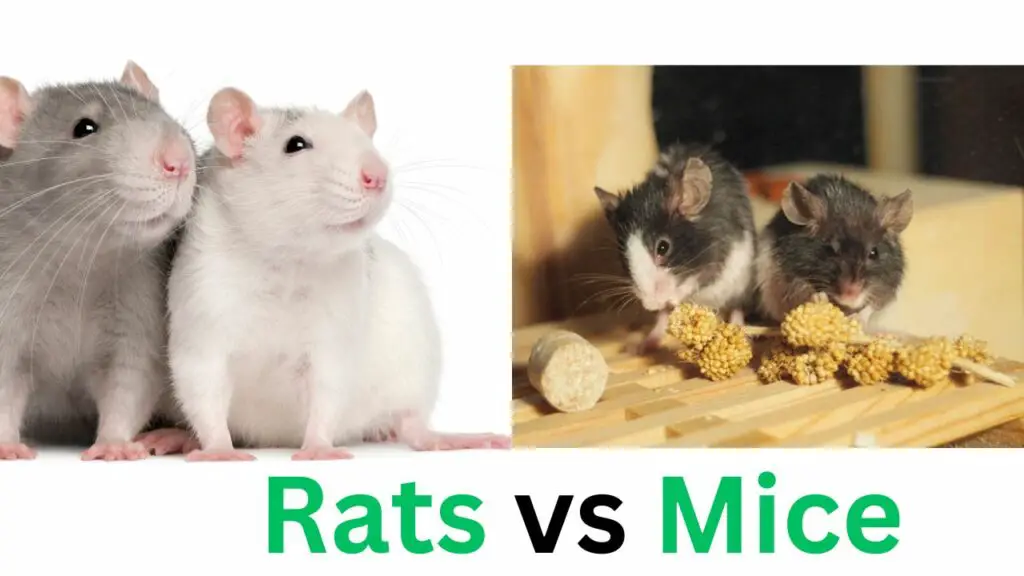Rats and mice have become increasingly popular as pets over recent years. They are small, easy to care for, and can be great companions.
However, choosing between the two can be a daunting task. In this blog post, we will discuss the physical characteristics, behavioral traits, living arrangements, feeding and nutrition, and health considerations, of both rats and mice to help you make an informed decision.

Physical Characteristics of Rats and Mice
Rats are larger than mice, with a typical length of around 9-11 inches, while mice are usually around 2-4 inches long. Rats have a thicker and more muscular body than mice, while mice have a slender and sleek body.
Rats have a wide range of coat colors, textures, and patterns, while mice are typically gray or brown. Rats have rounded ears and a long, hairless tail, while mice have large ears and a long, furry tail.
Both mice and rats come in a couple of variants, but the rat variants are more distinct and unique than the mouse variants. For instance, there are dumbo rats that have unique ears, and rex rats that have curly hair, whereas the mouse variants usually just have a slightly different coat.
Behavioral Traits and Temperament
Rats are social animals and enjoy the company of humans and other rats. They are intelligent and can be trained to do tricks. They are also known for their playful and curious nature.
Mice can also be social, but they are not as friendly as rats. They are more skittish and tend to hide when they feel threatened. Mice are also less intelligent than rats.
Mice also have a higher tendency to bite you because they’re usually a bit more scared of you.
Living Arrangements and Cage Requirements
Rats and mice require separate cages, as rats are much larger and require more space. The minimum cage size for a rat is around 2 cubic feet, while the minimum cage size for a mouse is around 0.5 cubic feet.
Both rats and mice need bedding material to create a comfortable and warm environment. For rats, a cage with multiple levels, hammocks, and hiding places is recommended, while mice need exercise wheels and hiding places in their cage.
Feeding and Nutrition
Rats and mice are omnivores and require a balanced and varied diet. Commercial rodent feed is available, but fresh fruits, vegetables, and protein sources such as eggs and cooked meat should also be included in their diet. Rats and mice also require fresh water at all times.
Health Considerations and Risks
Rats and mice can both develop a range of health problems, including respiratory infections, tumors, and dental issues.
Regular check-ups with a veterinarian experienced in small animals are recommended to ensure their wellbeing. Rats are also prone to obesity, and mice can develop aggressive behavior if kept alone for too long.
Conclusion
Rats and mice can make great pets, but choosing between the two requires careful consideration of their physical characteristics, behavior, living arrangements, feeding and nutrition, and health considerations.
It is important to ensure that you are able to provide the appropriate care and environment for your pet of choice. Ultimately, the joy and companionship that rats and mice can provide make them wonderful additions to any household.
On the whole, if you want a pet that’s more intelligent and affectionate, rats are the better choice. Rats are extremely social and are very smart, to the point that they can learn almost any trick.
If you prefer the cute appearance of the mouse though, then mice are great pets as well. They might be a little bit less intelligent and affectionate, but their independent nature can be a great fit for certain people.
- How Long Do American Eskimo Dogs Live? Important Factors and Care Tips - September 29, 2023
- Do American Bulldogs Need Grooming? Essential Tips and Care Guidelines - September 29, 2023
- Do Bengal Cats Enjoy Playing? Essential Tips for Keeping Them Active - September 29, 2023